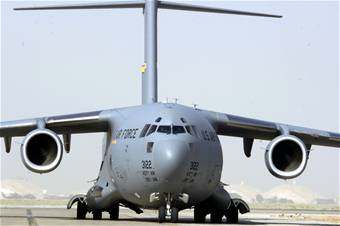 Boeing will have to start shutting down work on C-17 long-lead parts by Aug. 18, unless it receives a “clear commitment” from the Air Force that the service will pursue more of the aircraft. So says Dan Page, Boeing’s director of airlift business development. Boeing technically reached the cutoff point about a year ago, and has floated continued production on its own dime—to the tune of $100 million—in hopes of getting more USAF orders as well as some from overseas. A year ago, USAF was still talking 222 aircraft and another multiyear buy. Since then, however, the Quadrennial Defense Review called for ending production at 180 aircraft. Even with two foreign orders from Canada and Australia, and at least three more added by Congress—for a total of 12—it’s not enough to keep the line going past 2009, Page said Thursday. While there’s discussion of NATO partners buying four C-17s and Sweden buying two, these either won’t happen quickly enough or are not sufficiently “solid opportunities” for Boeing to keep floating the line.
Boeing will have to start shutting down work on C-17 long-lead parts by Aug. 18, unless it receives a “clear commitment” from the Air Force that the service will pursue more of the aircraft. So says Dan Page, Boeing’s director of airlift business development. Boeing technically reached the cutoff point about a year ago, and has floated continued production on its own dime—to the tune of $100 million—in hopes of getting more USAF orders as well as some from overseas. A year ago, USAF was still talking 222 aircraft and another multiyear buy. Since then, however, the Quadrennial Defense Review called for ending production at 180 aircraft. Even with two foreign orders from Canada and Australia, and at least three more added by Congress—for a total of 12—it’s not enough to keep the line going past 2009, Page said Thursday. While there’s discussion of NATO partners buying four C-17s and Sweden buying two, these either won’t happen quickly enough or are not sufficiently “solid opportunities” for Boeing to keep floating the line.
The Air Force plans to conduct more intensive training—and Congress is set to help by boosting funding for exercises and so-called “campaigning” by hundreds of millions of dollars, particularly in the Pacific.

